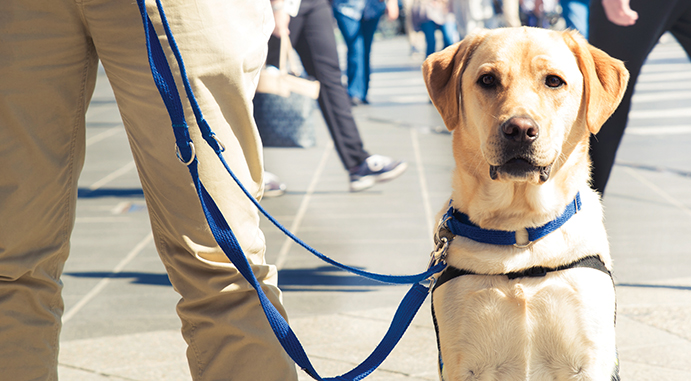The companionship and love that dogs give to their owners is well documented. But some of our furry friends truly lend owners and society a helping paw through extraordinary abilities to detect cancer, seizures, blood sugar levels and PTSD anxiety episodes, writes Dr Jo Righetti.
A helping paw
Our canine companions’ outstanding ability to detect and distinguish scents has led to careers in a variety of roles, including police detection, bio-detection, quarantine, truffle hunting and even medical alert roles. Combine this scent-detection ability, and the strong canine work ethic, with their devoted doggy dedication to their owners and dogs truly are able to save lives.
The canine nose
Your dog is a sniffing machine. With 220 million olfactory receptors in their nose and a scent-detecting brain area some 40 times greater than ours, dogs can identify scents around 1,000 times better than us.
For most of us, this means annoying behaviours like raiding garbage bins or sniffing crotches but, for many working dogs, the ability to detect scents is a life saver. Dogs are able to detect:
- low blood sugar levels in diabetes sufferers, due to the different scent emitted.
- types of cancers such as prostate cancer from a urine sample and lung cancer from a breath sample.
Can your dog sniff cancer?
Anecdotal stories abound of how dogs have helped detect disease in their owners. Initial interest was sparked when a woman’s dog showed tremendous interest in her skin lesion, which subsequently proved to be a malignant melanoma. While there is little supporting medical evidence for disease diagnosis, there is no doubt that dogs have an extraordinary ability to distinguish scents that differ from the usual.
To be able to reliably detect a medical condition does require training. The dog needs to be reinforced for detecting the desired scent and also trained to be a well-behaved member of society. It is unlikely that hospitals will rush to employ a kennel of dogs any time soon but dogs can excel within a family environment.
Dogs as support partners

It’s not only scent that dogs respond to. Seizure-alert dogs can sense and notify their human companions of an oncoming seizure. In sufferers of post-traumatic stress disorder (PTSD), dogs can alert their owners that an anxiety attack is about to begin and provide much-needed comfort and support.
Dogs can be trained to communicate with their handlers in various ways, like pawing at, jumping up or nudging the person. The dog is responding to stress-related indicators such as a rise in body temperature (sweating) or behavioural changes such as biting nails, placing hands in pockets or even a change in breathing patterns. This ability to alert an owner of their impending seizure or to bark when an owner requires help is a comfort to many people and to their families.
Jimmy, PTSD and Me
Rob has PTSD, and his assistance dog, Jimmy, a two-and-a-half-year old Labrador, is his source of support. Rob explains here, in his own words, just how Jimmy helped him get through his graduation ceremony.
“To you, this is just Jimmy being a dog: getting up and then barking in my face, nipping and licking at me. For me, on the outside it looks like I’m just sitting there chilling but on the inside I’m struggling to breathe, my mind is racing and my heart is pounding so hard I feel like it’s going to burst out of my chest. There’s noise all around me but it’s become indecipherable. Nothing’s making sense to me and I’m getting really overwhelmed. I’m sweating and I need to run. It’s the beginning of an anxiety attack.
Jimmy has been sitting quietly by my side. He glances at me every minute or so, checking in on me. He notices the subtle early signs of my anxiety – far too subtle for you to notice or for me to even to acknowledge. Using the intelligent disobedience that Assistance Dogs Australia (ADA) train into their dogs, Jimmy leaves his quiet sitting position and quietly nuzzles me a few times on my hands and leg.
I either ignore him from embarrassment or am way too wigged out to even notice. Jimmy then jumps up on me and barks loudly in my face. This gets my attention and then he nuzzles me until he senses I’m calming down. It forces me to acknowledge where I am, grounding me and allowing me to be present in the moment. Five minutes later he had to do it to me all over again. Jimmy’s early intervention allowed me to stay there, enjoy the ceremony, give a speech, engage with people, most importantly with my family, and not run away, hide or use anger to deal with uncomfortable situations. This is the skill and magic these dogs have.”
Read more about Jimmy and Rob at www.facebook.com/Jimmyptsddog
ABOUT
Dr Jo Righetti
Dr Jo Righetti is an animal behaviour consultant who helps people understand pets and the human-animal relationship. Her website has lots of advice on pets. Dr Jo is a proud Ambassador of Assistance Dogs Australia.
Website www.petproblemsolved.com.au.























The time has come for not only retirees but every one to push for older people retiring to be able to keep their pets living with them.
It is cruel to expect that you leave your animals behind.
What is your opinion?